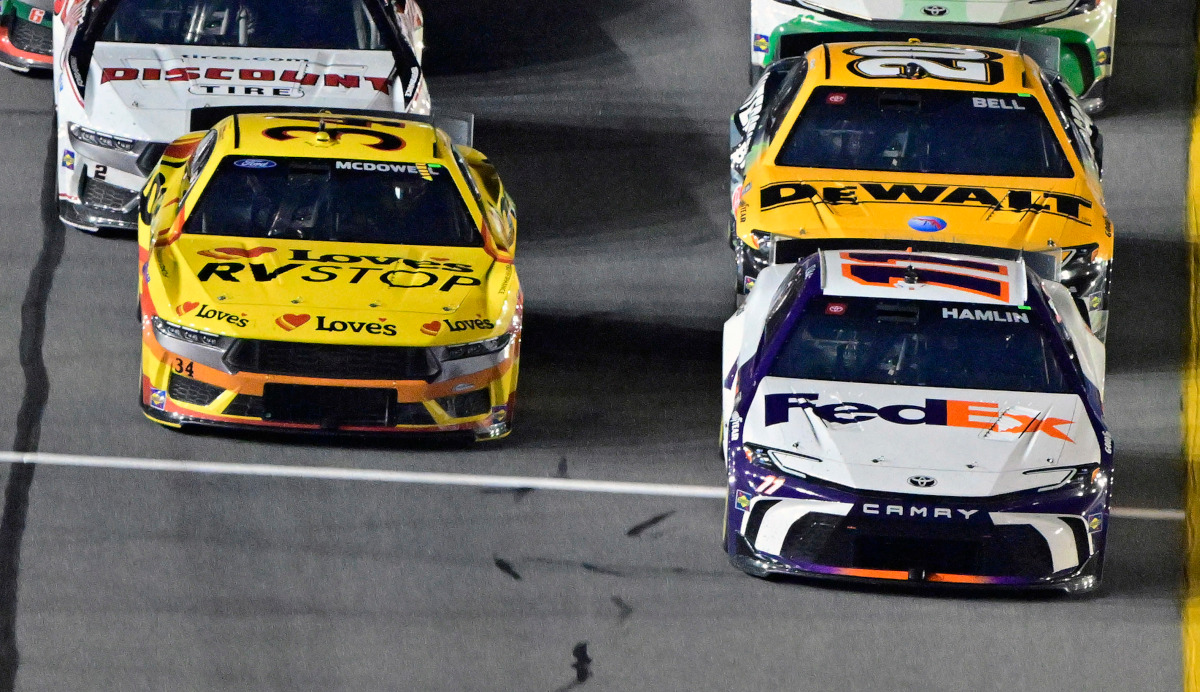Thursday night’s qualifying races at Daytona International Speedway were particularly important to the Ford and Toyota camps as both kept close watch of their redesigned bodies.
It was unknown how the Ford Mustang Dark Horse and Toyota Camry XSE would react in the draft and how they would push teammates. The expectation was that it would be better, even more stable to push draft, but the first chance to find out came with the high stakes of competing for a spot in the Daytona 500.
Friday morning, both sides were breathing a little easier.
“We were really curious to see how things were going to play out in the Duels because that’s our first opportunity with the new car in traffic,” Mark Rushbrook, global director of Ford Performance, said. “We didn’t have the numbers in the first race with only four or five Mustangs in there. Certainly, had the numbers in the second race, and we got a lot of feedback and comments from the drivers and some things that could be worked on with the setup to optimize that. But, at this point, we’re still very happy with the new car and looking forward to seeing how things play out.”
Ford didn’t win either one of the Bluegreen Vacations Duel races. In the first race, the highest-finishing Ford was Joey Logano, finishing seventh — one of just four Ford drivers in the first race.
In the second, Austin Cindric was the highest-finishing Ford as the runner-up. The manufacturer had 12 drivers in the second race.
Although shut out in race competition, Ford is riding high from single-car qualifying, where they swept the front row for the Daytona 500. Logano will start from the pole with Michael McDowell alongside him.
“We normally don’t place a lot of emphasis on qualifying here because what matters at the end of the day is how the cars race,” Rushbrook said. “But it still was nice to get that front row, especially for Roger Penske to get a pole here. That was on his list of accomplishments that he wanted to add to, and really happy to see Front Row up there next to Penske.”
A Toyota driver won both of Thursday’s races. Tyler Reddick led the one key lap in the first Bluegreen Vacations Duel. There were five Toyota drivers in the first race, and they combined for 20 laps led. Reddick was the first of three Toyota drivers who finished inside the top 10.
[lawrence-auto-related count=3 category=1428]
In the second race, Christopher Bell made a last-lap pass. He, too, led just the one lap. Again, three Toyota drivers were inside the top 10 of the four drivers in the race. They combined for 27 laps led.
“Obviously it’s tough…when you develop a body and you’re just looking at CFD and some wind tunnel data, and you have no idea what’s really going to happen when you get in traffic on the track,” Paul Doleshal, general manager of motorsports for Toyota Motor North America. “But I think we were a little bit disturbed – probably a strong word — but surprised at the lack of qualifying speed, but then felt that the car would race well, and that proved out, so we’re encouraged with that. I think it’s just figuring out where the car wants to sit and kind of working on some of the things from a setup perspective, which the teams and TRD will be actively pursuing and already have been.
“I don’t think we have a lot of worries; we know there’s a learning curve any time you change a body or major component like that, especially from an aerodynamic standpoint. We’ll just keep digging on it, but we should be fine as we work through it. The drivers seem to have good feedback on the car, how it was in traffic and performed on the superspeedway. We’re encouraged.”
Of the three manufacturers in NASCAR, Chevrolet goes into the season without a change to its body. Chevrolet’s Camaro might be coming out of production for street vehicles, but the model will still compete in NASCAR for the foreseeable future.
Chevrolet teams can jump out to an early advantage while their rivals work through fielding new cars, but Jim Campbell, the vice president of performance and motorsports for Chevrolet, isn’t looking at it that way or anticipating much.
“Well, we will see here this weekend. Hopefully this weekend, [and] if not this weekend, soon,” Campbell said of any gap between the three manufacturers. “The one thing that NASCAR has done in the ruleset is they keep us in a pretty tight box and keep the competition tight. Basically, in downforce and drag, they have parameters that you are required to stay within. Our car is within that box, as are the other two OEMs. It’s going to be tight.
“You can see out there in the Duels how tight that is going to be. The one thing that we do have, because our body is the same as last year, is just continuity and momentum in development in preparation and simulation versus the time that we have had to switch to a new body — we spent a lot of time on that switchover. That is a positive, but you can see how tight it is out there, and that is mainly because of the rule settings that NASCAR has on downforce and drag requirements.”
